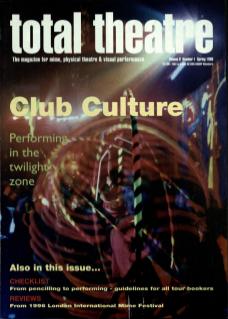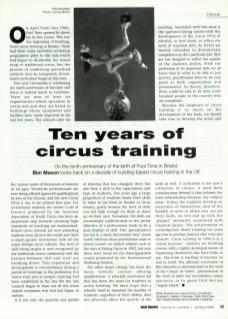On April Fool’s Day 1986, Fool Time opened its doors for its first course. This was the beginning of building-based circus training in Britain. There had been some excellent workshop programmes prior to this date which had begun to demystify the closed shop of traditional circus, but the process of combining specialised subjects into an integrated, broad-based curriculum began at this time.
This year Circomedia is celebrating the tenth anniversary of this date and there is indeed much to celebrate. There are now at least six organisations which specialise in circus arts and they are based in buildings whose equipment and facilities have vastly improved in the last few years. The schools cater for the various needs of thousands of trainees of all ages. Would-be professionals are now being offered approved qualifications by two of the schools, and the new Circus NVO is due to be piloted this year. For recreational students the recent Code of Practice produced by the National Association of Youth Circus has been an important step towards ensuring high standards of teaching are maintained. British circus schools are now attracting students from all over the world and there is much greater interaction with all the major foreign circus schools. The level of skill being taught is now recognised by the traditional circus community and the barriers between 'old' and 'new' are breaking down. This expansion and development is extraordinary during a period of shrinkage in the profession; it is ironic that just as proper training had been established in the late 80s the Arts Council began to wipe out all the circus related companies that had just begun to mature.
It is not only the quantity and quality of training that has changed; there has also been a shift in the expectations and type of students. Ten years ago a large proportion of students learnt their skills in order to use them in theatre or circus theatre, partly because the level of skills was not high enough for them to stand up on their own. Nowadays, the skills are increasingly sophisticated so the prime objective of a performance tends to be a pure display of skill. This specialisation has led to a more introverted 'new' circus world; whereas circus practitioners used to attend courses on related subjects such as the one on Peking Opera in 1992, last year there were none on the Kalarippayattu course promoted by the International Workshop Festival.
The other major change has been the move towards courses offering qualifications. A principle motivation for this has been the need for students to access funding. We must hope that a school’s need to maintain the number of students, regardless of their ability, does not adversely affect the quality of the teaching. Associated with this issue is the question being raised with the development of the Circus NVQ of whether, or how much, to reflect the level of acquired skill. As NVQs are merely intended to demonstrate competence to do a particular job, they are not designed to reflect the quality of the students ability. With the profession in its depressed state we all know that in order to be able to just survive, practitioners have to be very good at both organisation and performance. In theory, therefore, there could be said to be only a few hundred people in the country who are competent.
Because the emphasis of circus training is so much on the development of the body, we should take care to develop the mind and spirit as well. A curriculum is not just a collection of classes, it must have consciousness behind it that informs the inter-relationship between the subject areas. Unless the students develop an awareness of themselves, and of the breadth of styles in which they can use their skills, we will end up with the 'puppet' mentality associated with classical dance. The achievement of contemporary dance training ten years ago was to produce dancers who were also creators. Circus training in 1996 is at a crucial juncture – students are finishing courses with a highly developed means of expressing themselves but have little to say. The form is tending to become an end in itself. The ultimate conclusion of this direction is demonstrated in the work of the Cirque du Soleil – phenomenal in the level of skills but nevertheless empty spectacle, or to quote Dick McCaw, ‘sugary kitsch’.

